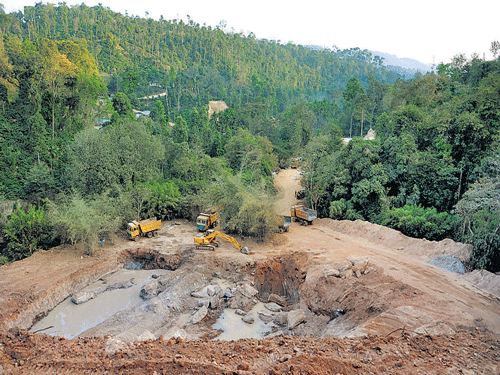
The State government has quietly started work on the Yettinahole project in the pristine Western Ghats in Sakleshpur taluk of Hassan district, much to the locals’ chagrin. The residents are terming the work illegal as the project ‘lacks’ the necessary green clearances.
Through the Rs 13,000-crore project, the government plans to provide drinking water to the Kolar, Chikkaballapur and Tumakuru districts and parts of Bengaluru City.
The silence of the forests in Sakleshpur has been disturbed in the last two weeks with heavy machines being deployed for the project to divert the Yettinahole waters from Sakleshpur’s Kenchanakumari and Kempuhole reserve forests. The locals, shocked by the ongoing work, say that neither a notification for starting the work was issued nor was a public hearing conducted as mandated, before taking up a project of this magnitude. Hundreds of trees have been axed for the project.
Expressing apprehensions that the illegal project will leave the downstream dry, hitting the livelihood of locals, the affected people have begun efforts to stall it. “There are several villages downstream depending on Yettinahalla (Yettinahole) for their water. This place is also an ecologically sensitive region. If the water is diverted upstream, there will be a disaster,” said H A Kishore Kumar, president, Malenadu Janapara Horata Samiti.
The people said that they were not against the project. But, they have demanded that the government conduct an Environment Impact Assessment (EIA) of the project, a study of the social impact due to the diversion, and hold a public hearing. “We made a request to Water Resources Minister M B Patil in this regard when he visited Sakleshpur on December 22, 2014. He promised to look into it. But shockingly, work has begun,” said Kumar. “Even the necessary land has not been acquired for the project,” he said.
Minister Patil told Deccan Herald that the project did not require a forest clearance. “This is a drinking water scheme and is exempted from forest clearance,” he said. The work had begun on a small scale in the forest areas, he said.
The locals said that this was not a drinking water project as the detailed project report says it aims to irrigate 28,000 hectares of agriculture land by filling up 331 tanks and plans to generate 125 megawatt of power. “Any project proposal to generate above 50 MW of power falls within EIA 2006, which requires compulsory forest clearance,” said a wildlife enthusiast.